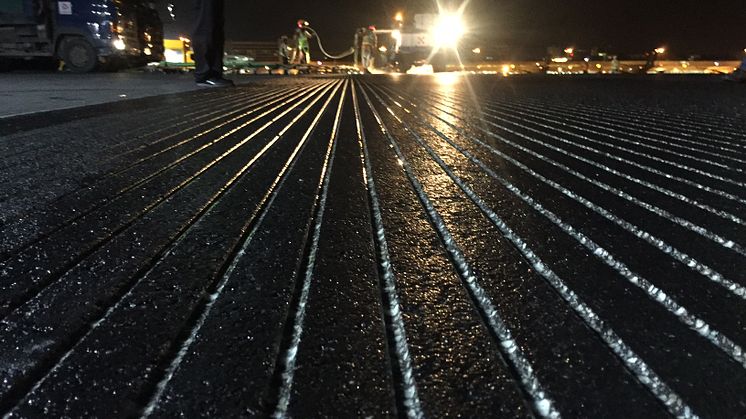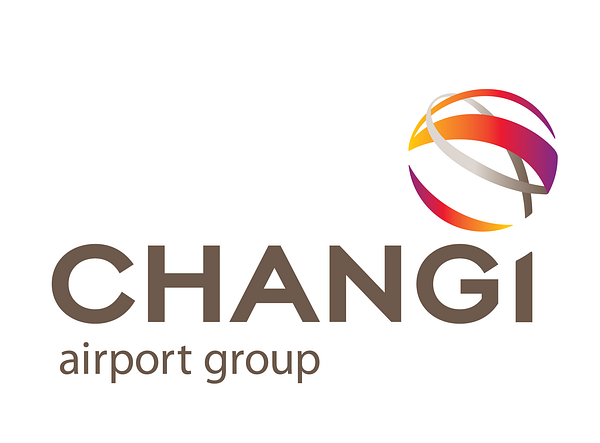
Press release -
Changi Airport enhances safety and productivity with Asia’s first trapezoidal grooved runway
SINGAPORE, 29 Sep 2016 – Changi Airport is stepping up its productivity and safety drive in the airfield with new and improved runway maintenance processes. These include the cutting of grooves, and the use of a stronger asphalt mix to resurface the airport’s runways.
Runway grooving to enhance surface drainage
The surface of Changi Airport’s Runway 1 is currently being cut with trapezoidal-shaped grooves, a new safety design developed by the Federal Aviation Administration of USA. This method of improving runway surface drainage, especially in the advent of climate change leading to higher intensity rainfall, has not been used in any airports in Asia. Cut by a special machine for runway grooving, the trapezoidal grooves have been shown to provide better water drainage than traditional square grooves, especially under adverse weather conditions. This enhances the safety of aircraft operations by reducing the risk of hydroplaning, which happens when a layer of water builds between the aircraft tyre and the runway surface, causing skidding.
Trials conducted at Changi have also shown trapezoidal grooves to be more maintenance-friendly as compared to its square counterpart, when it comes to removing rubber deposits of aircraft tyres wedged inside the groove.
Stronger asphalt mix to resurface runways
Concurrently, Runway 1 is being resurfaced with a stronger and more durable asphalt mix, which was jointly developed with the Civil Engineering Department of the National University of Singapore. The mix was tested over three years to ensure it achieves a higher temperature resistance, in anticipation of hotter weather from climate change.
Every week, more than 6,800 flights take off and land on the two runways at Changi Airport. The impact of the aircraft tyres on contact with the ground will cause the pavement surface constructed of asphalt material to age. Regular preventive maintenance of the runways and taxiways is hence essential to ensure pavement quality. This allows safer and smoother aircraft movements and enables Changi Airport to continue handling heavier aircraft loads and higher traffic growth.
The grooving and resurfacing of Changi Airport’s Runway 1 have been ongoing since October 2015 and are expected to be completed by this year-end. Runway 2 has recently been resurfaced.
New runway maintenance equipment to boost operational efficiency
At the same time, new equipment have been procured to enhance maintenance productivity in the airfield. These special equipment are essential to ensure the surface evenness and friction on the runways.
Each time an aircraft lands, its tyres will deposit rubber residue which sticks to the pavement surface. To ensure the runways maintain good skid resistance, Changi Airport has deployed a new rubber removal machine that uses the mechanism of ultra high-pressure jet washing to remove the aircraft tyre rubber build-up, at an increased rate of 3,000 sqm/h as compared to the previous 2,300 sqm/h. The enhanced two-men operation model of the new machine, which previously required seven staff to operate, helps to increase productivity on site.
Changi Airport closes one runway every night for less than six hours for regular inspection and maintenance works. Besides runway resurfacing, pavement grooving and the removal of rubber deposits, other works include the servicing of airfield lighting, repainting of pavement markings and grass cutting alongside the runway. More advanced machinery are now used for the repainting of pavement markings and grass cutting.
Teng Hwee Onn, Senior Vice President of Engineering Management & Systems Planning at Changi Airport Group (CAG) said, “The measures that we have implemented in recent years have proven beneficial and have increased operational efficiency by about 20%, by reducing the time and resources needed to complete the same maintenance works in a night. The reduced maintenance hours have translated to additional running hours for aircraft operations, which is crucial to continued air traffic growth. CAG will continue to review and refine processes along the way to enhance aircraft safety and staff productivity.”
Topics
Categories
About Changi Airport Group
Changi Airport Group (Singapore) Pte Ltd (CAG) (www.changiairportgroup.com) was formed on 16 June 2009 and the corporatisation of Singapore Changi Airport (IATA: SIN, ICAO: WSSS) followed on 1 July 2009. As the company managing Changi Airport, CAG undertakes key functions focusing on airport operations and management, air hub development, commercial activities and airport emergency services. CAG also manages Seletar Airport (IATA: XSP, ICAO: WSSL) and through its subsidiary Changi Airports International, invests in and manages foreign airports.
Changi Airport is the world's sixth busiest airport for international traffic. It served a record 55.4 million passengers from around the globe in 2015. More than 360 retail stores and 140 F&B outlets are situated across three terminals to cater to passengers and visitors. With over 100 airlines providing connectivity to 320 cities worldwide, Changi Airport handles about 6,800 flights every week, or about one every 90 seconds.
